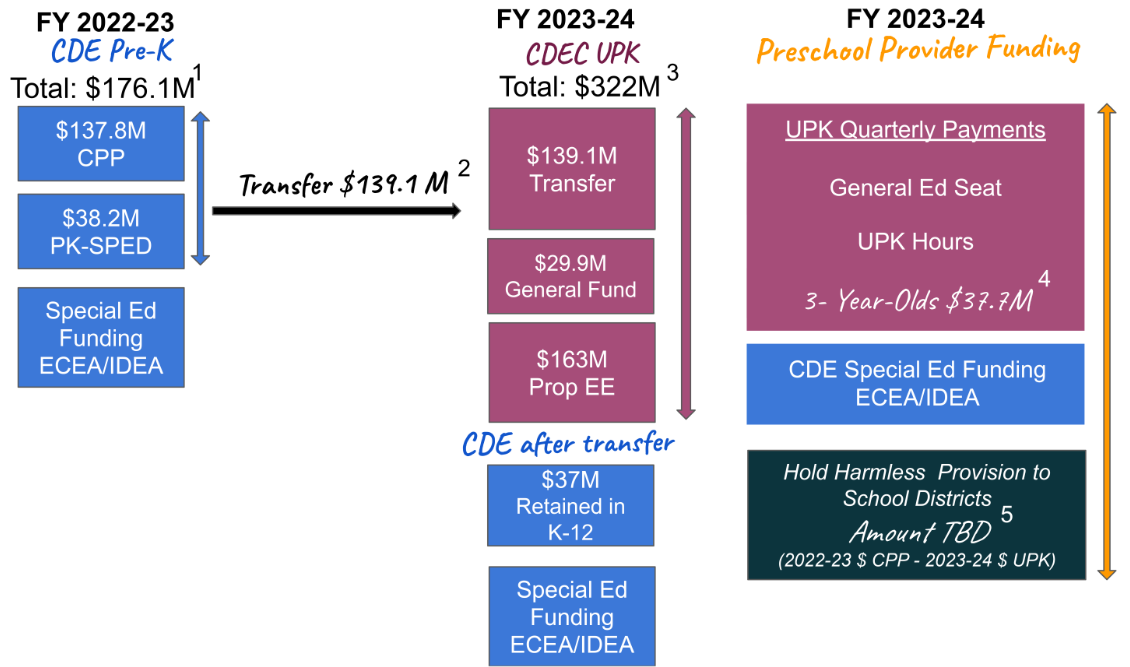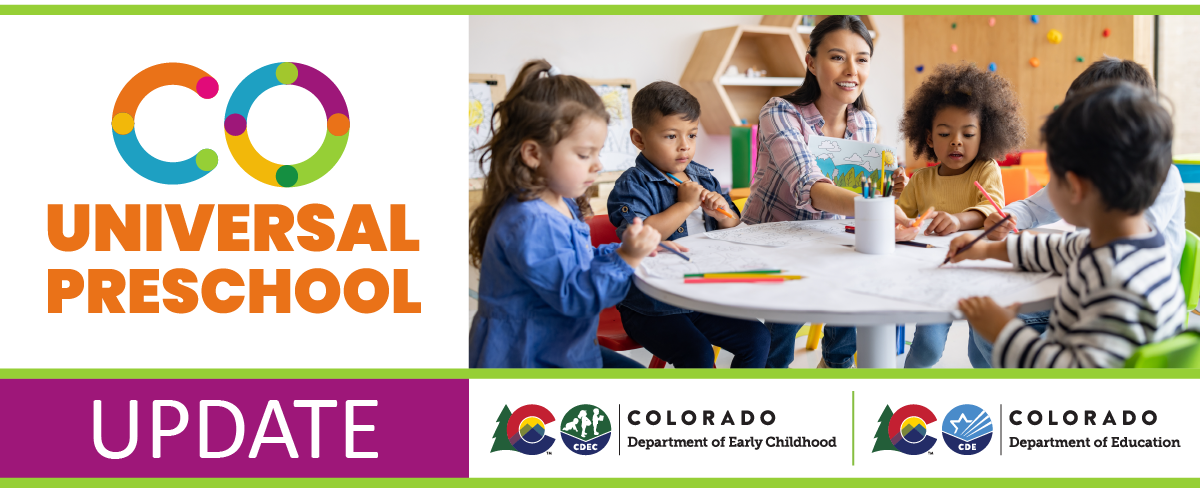You are here
Colorado Universal Preschool Update - Feb 28, 2023
Feb. 28, 2023
UPK statute prioritizes serving preschoolers with disabilities
Under the UPK statute, beginning in school year 2023-24, funding from the Preschool Program Cash Fund (PPCF) administered by CDEC will be provided to qualifying providers, and according to statute must be prioritized as follows for students:
- All eligible preschool students with disabilities in accordance with IEPs.
- 4-year-olds / year-before-kindergarten – a minimum of 10 hours/week.
- Eligible 3-year-olds (and younger with historical waiver) who meet a qualifying factor per rule.
- Additional hours for eligible 4-year-olds / year-before-kindergarten, per rule and subject to available appropriations.
K-12 per pupil funding increase for some districts with the removal from School Finance Act Funding Formula of CPP and preschoolers with IEPs
After CPP students and preschool students with an IEP are removed from the School Finance Formula, $37 million will be retained in K-12 and may increase the per pupil revenue for some districts, as well as increase per pupil floor funding. This $37 million is a result of the mechanics of the School Finance Formula (see note), specifically the size factor. The Transfer [4-209(1)(b)(I)] from Total Program to the Preschool Cash Fund is calculated as the difference between the State Share of Total Program formula after the application of the Budget Stabilization Factor with and without including the statewide preschool program enrollment.
Following the direction of statute, CDE and CDEC have run this model and have determined that the difference between the FY 2022-23 formula with and without Colorado Preschool Program students and preschool students with IEPs is $139.1 million. The total funding received by districts for CPP and special education preschool based on district per pupil revenue is $176.1 million in FY 2022-23. The difference of $37 million will be retained by K-12. While students with disabilities are included in the calculation of the formula for this transfer, it is important to note that distributions on behalf of students with disabilities are not limited to this transfer formula, and that the Preschool Program Cash Fund has multiple sources of revenue for its ensuing distributions.
Note: The School Finance Formula operates wholly separately from "categorical" special education-specific funding (IDEA/ECEA funding), and thus, "removal" of preschool "general education" funding from the School Finance Formula has no impact on IDEA/ECEA special education-specific funding.
The following flowchart outlines the various funding sources currently and under the Universal Preschool Program:\

- Funding Transfer. Section 26.5-4-209, C.R.S. requires a transfer of the difference between the state share of total program in FY 2022.23 budget year and the state share of total program without CPP and SPED PK. This "state share of total program" is not inclusive of special education specific funding via IDEA and ECEA. After the transfer from the total amount of funding, $37M is retained by K-12.
- Transfer amount. The transfer amount is the difference between the FY 2022-23 formula run with PK-12 students and K-12 students, which is $139.1M.
- UPK Funding. The Joint Budget Committee approved a total of $322M for Universal Preschool during figure setting.
- Funding for 3-Year-Olds. Section 26.5-4-208 instructs that for eligible 3 year-olds with Qualifying Factor(s), or similarly situated under-3-year-olds within a historical CPP waiver community, CDEC shall distribute funding in accordance with those services. As with other services paid for under the UPK program, this "bucket" will have access to multiple forms of revenue within the Preschool Program Cash Fund. However, statute does also contemplate a specific "floor" of dollars held in the fund for these expenses, at the very least. That minimum of funding for FY 2023-24 is $37.7M.
- Hold Harmless. Section 26.5-4-208(4), C.R.S. requires that if the funding that a school district or a charter school receives based upon per-child rates for FY 2023-24 is less than the funding for FY 2022-23 for CPP, CDEC shall distribute the difference to the school district or charter school.

The following questions and answers summarize questions received from districts during the last town hall meeting hosted by CDEC as well as questions received from CASE.
When will we know if we have funding for full-day children in the year before they are eligible for kindergarten?
CDEC will monitor applications as the matching process begins to better determine the funding available for families that are eligible for full-day UPK. The week of April 10 has been targeted to assess the number of applications against the total eligible population and to review the number of children that qualified for full-day services. At that point, CDEC will be better positioned to determine if more data is needed or if we can begin to commit to full-day placements.
What "pots" of money that districts formerly received will be used to determine hold harmless? How will Hold-harmless dollars be determined?
Statute indicates there may be variations in funding among school districts during the transition from CPP to UPK. The average base per pupil funding in SY 2022-23 for CPP and preschool students with an IEP is $4,797.91, with a range from $4,529 to $10,333. The average base per pupil funding in SY 2023-24 for 10 hours of UPK is $4,837 and $6,044 for 15 hours.
The hold-harmless provision [4-208(4)(a)-(b)] focuses on district/provider-specific funding levels between school years 2022-23 and 2023-24. The hold-harmless provision only applies if a school district or community-based provider has lower funding through UPK than the amount of funding generated through CPP to serve children in the 2022-23 fiscal year. Restated, the formula looks at how much funding each provider receives in 23-24 for all UPK-eligible children the district/provider serves; and compares it to the amount received in 2022-23 for CPP children served by each district/provider. If the 23-24 amount for a district/provider is lower than the 22-23 amount, then the district/provider will be distributed the difference for one year. CDEC will not know the actual hold-harmless amount for districts and providers if any until UPK Colorado is underway. The hold-harmless provision is only applicable for one year. Hold-harmless funding would be funded from the Preschool Cash Fund, which includes several revenue streams, specifically, Prop EE and the Transfer [4-209(1)(b)(I)] from Total Program.
Is preschool funding tied to the Student October Pupil Count Date?
No, districts no longer have to provide funding for preschoolers who enroll after the pupil count date. CDEC will provide funding for students as they enroll throughout the year. CDEC is in the process of selecting a payment vendor. CDEC expects to make payments to providers throughout the program year, with true-ups based on enrolled students.
How will IDEA and ECEA funding continue to flow to support preschool students with IEPs?
The federal Individuals with Disabilities Education Act, or IDEA, funding model includes total student populations and students living in poverty. The funding model for the Exceptional Children's Educational Act, or ECEA, includes counts of students in Tier A and Tier B from CDE's December Special Education Count. Preschool students with IEPs will continue to be counted in the CDE December Student Count. The funding formulas for both IDEA and ECEA funding will remain the same in FY 23-24 and beyond. Therefore, Administrative Units will continue to receive funding to provide special education and related services for preschool students with IEPs, which augments the general education funds provided through the Preschool Program Cash Fund.
What is the specific process for holding special education spots? How will funding work for districts holding spots since we will have to keep some spots back? On the SPED topic, there should also be an acknowledgment that the IEP determines the hours. It's not simply a choice between 15 and 30.
CDEC recommends school districts put the total number of seats only for eligible 4-year-olds in the system and then leverage the exception process to "hold" seats for students with an IEP. Here's an example: A school has 20 seats in a classroom. The school would hold 10 of those seats for 3-year-olds with IEPs or at least one qualifying factor and submit the remaining 10 seats into the UPK Application Portal for 4-year-olds. If none of the 10 4-year-old students who are matched to that site have an IEP, the district could then decline an appropriate number of the non-IEP matched students based on historical enrollment of students with IEPs, plus any additional information regarding changes to historical trends. This action would create spots for current or future students with IEPs anticipated to need to enroll at that location. The "decline" exceptions include this reason as the number of students who would receive a decline message would be based on how many IEP slots are being held in that classroom, which could be different in each classroom.
We are aware and acknowledge that a student's IEP will determine the appropriate number of hours the student needs in order to meet the special education needs of the child. Although a child may be eligible for a full day (30 hours) of UPK, that may not mirror the requirements of the IEP, and in that case, the IEP will be the determining factor. In addition, any child determined eligible for special education services, and placed in an appropriate educational program by the Administrative Unit, is guaranteed UPK funding as long as the provider is consistent with the child's IEP. If families choose a provider that is not consistent with the child's IEP, the child no longer qualifies for the hours of service related to their IEP status.
While this isn't a first-come, first-served process, it appears that UPK slots are filling faster than perhaps capacity allows. Will there be funding in the fall for families who register late? How can districts highly impacted by poverty assure our families that there is room for them in the fall?
CDEC recommends that school district providers manage these seats as they have in the past. If a district customarily holds a number of seats for new families, that process may continue. Many districts will keep enrollment open only until they are full, and then will be unable to serve new families. We anticipate we will have funding to continue to enroll new students during the school year, and should a child enroll with a participating provider that has space for the child, we would begin to fund that child.




Connect With Us





